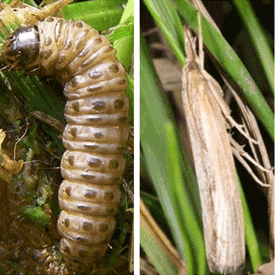A Plus Fertilizing
Residential and Commercial

If you are having an issue with this insect, please contact us to help you make the right choice for your property.
insects
Hairy Chinch Bugs
Sod webworms start off as caterpillars. They live in the thatch just above the soil. They feed at night on the undersides of leaves. The caterpillars can grow to one inch in length.
Adult moths will begin to emerge late May to early June depending on temperatures. This is when they are most visible. You will see the moths flying in a jerky motion. The adult moth is not the destructive part of this insect’s life. It is the larvae (caterpillar) that is destructive. The problem is that all those little moths are laying eggs. Sometimes a female can drop as much as 200 eggs while flying. It takes 5 to 10 days for the larvae to hatch and start feeding. Damage will appear minimal at first but as the larvae mature the more damage they will be capable of. Sod webworms have two generations a year.
- Start off as caterpillar(larvae).
- Larvae is when pest is most destructive.
- Has two generations each year.
- Appearance of adult moths is first sign of possible future damage.
- Over winter as larvae.
Prevention Tips
- Thatch your lawn regularly. Sod webworm larva (the worms), which is the most destructive time of the sod-webworms life, is spent in the thatch of your lawn spinning webs and feeding on the foliage of the turf grass. Less thatch=less desirable home.
- Have a plan. Having a proper fertilization and insect control plan is very important. Be ready ahead of time, rather than trying to play catch-up when it is too late.
- Scouting. Pay attention to small white moths flying in a herky- jerky ,zig- zag pattern. These are sod-webworms and each time they land they are capable of laying hundreds of eggs each time.
- It is also important to not get confused by drought damage, symptoms can appear similar.



Contact Us